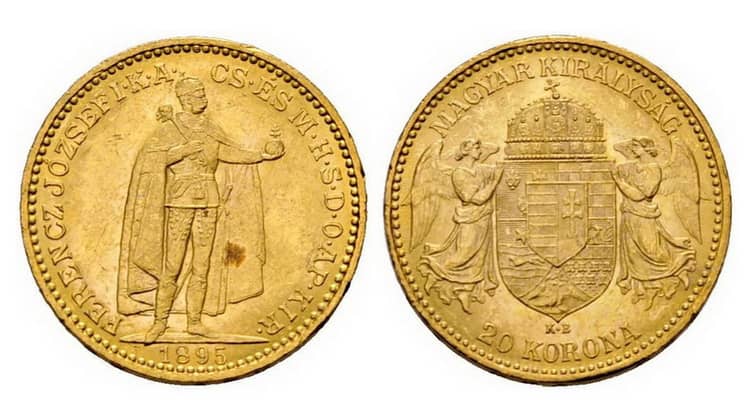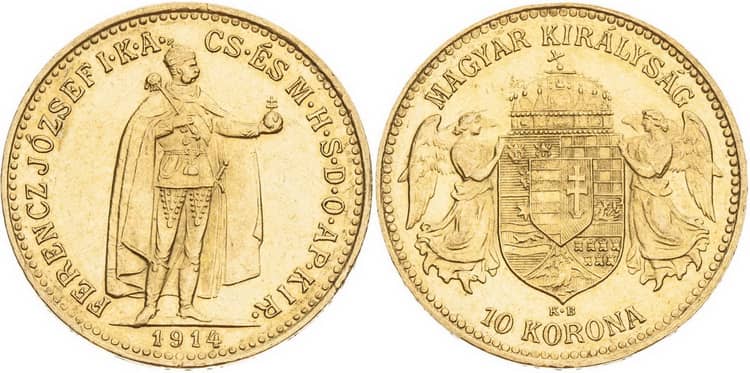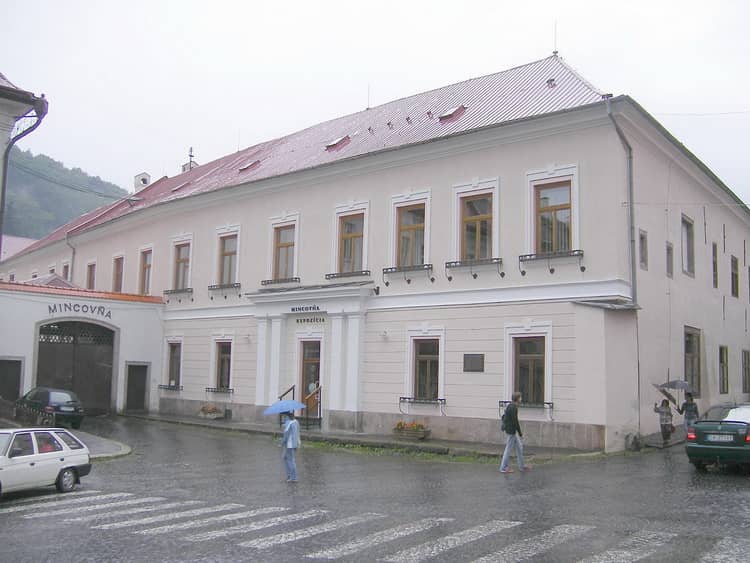
10 Hungarian korona (1892-1914, without 1892 edition) were minted together with other denominations of gold coins − 20 and 100 korona − and were in circulation only in Hungary. It should be noted that this coin is almost the same in design as 100 and 20 Hungarian korona. In contrast to the similar coins of the Austrian type, the Hungarian korona contains all the inscriptions in Hungarian and depict the royal regalia of the country. All Hungarian gold coins in our catalog.
Coins of 10 korona denominations (1892-1914)
- Obverse: In the center of the coin, the emperor of Austria-Hungary and the apostolic king of Hungary, Franz Joseph II, is depicted in full stature. He holds the power in his left hand, the scepter in his right, and the crown of Hungary is put on his head. The year of stamping is indicated under it, and the inscription “FERENC JÓZSEFI * K * A * CS * ÉSM * H * S * D * O * AP * KIR *” is engraved in a circle. On the edge of the coin there is a decorative dotted border.
- Reverse: In the center of the coin there is the national emblem of Hungary, topped with a crown, and on both sides of them there are the Angels. Under the emblem stands the mark “K * B”, and under it the denomination of the coin “10 KORONA” is indicated. “MAGYAR KIRÁLYSÁG” is engraved on the upper edge of the coin, and the edge is decorated with dotted edging. You can find all 10 Korona Hungarian gold coins in our catalog.
- Edge: pattern.
- Metal: Au 900 / Cu 100.
- Diameter: 19 mm.
- Weight: 3.3875 g.
- Edge thickness: 0.9 mm.
- Obverse design: Jósef Reisner (Jozef Reisner).
- Reverse design: Gerl Károly (Gerl Caroli).

Coins circulation of 10 korona denomination (1892-1914)
| Year of Issue | Circulation (pcs.) as uncirculated |
| 1892 | 1087000 |
| 1894 | 986000 |
| 1896 | 32000 |
| 1897 | 259000 |
| 1898 | 218000 |
| 1899 | 231000 |
| 1900 | 228000 |
| 1901 | 230000 |
| 1902 | 243000 |
| 1903 | 228000 |
| 1904 | 1531000 |
| 1905 | 869000 |
| 1906 | 748000 |
| 1907 | 752000 |
What Mint produced the coins?
Hungarian gold coins of 10 korons were minted in the Kremnica Mint, which is located on the territory of modern Slovakia. All Slovakian gold coins in our catalog. On the reverse of all coins you can find the stamp of this mint − “K * B”, which is an abbreviation of the Hungarian name of the city Körmöcbánya (Kremnica). In addition to 10 crowns, there were minted fillers with denomination of 1, 2, 10, 20 and korona with denomination of 1, 2, 5, 20 and 100.
The cost of these coins on the market
If you pay attention to the circulation of coins of this denomination, you will note that they were quite large, so their price on the market today will be relatively small. However, it is almost two dozen times higher that the nominal. Also, the value of the coin will be determined by its condition at the time of purchase / sale and the current value of the gold of this sample on world exchanges. All 1848 – 1916 Hungarian 10 Korona gold coins in our catalog.

The approximate value of the Hungarian gold coins of 10 korona of 1892-1914:
- 10 korona of 1892 − USD $ 178.56-225.00;
- 10 korona of 1894 − USD $ 174.86;
- 10 korona of 1896 − USD $ 122.97;
- 10 korona of 1897 − USD $ 145.13-258.60;
- 10 korona of 1898 − USD $ 235.09-258.60;
- 10 korona of 1900 − USD $ 163.91;
- 10 korona of 1901 − USD $ 163.91;
- 10 korona of 1902 − USD $ 163.91;
- 10 korona of 1903 − USD $ 235.09-282.11;
- 10 korona of 1904 − USD $ 145.13-204.00;
- 10 korona of 1905 − USD $ 163.45;
- 10 korona of 1906 − USD $ 225.00;
- 10 korona of 1907 − USD $ 164.58;
- 10 korona of 1908 − USD $ 145.13;
- 10 korona of 1909 − USD $ 225.00;
- 10 korona of 1910 − USD $ 411.41-1880.72;
- 10 korona of 1911 − USD $ 183.64;
- 10 korona of 1912 − USD $ 183.64-250.00;
- 10 korona of 1913 − USD $ 705.27-1175.45;
- 10 korona of 1914 − USD $ 352.63-470.18.

Interesting Facts
- Together with the Hungarian gold korona of 10, 20 and 100 denominations in the period of 1982-1914 there were silver korona in denominations of 1, 2 and 5, as well as fillers of alloys of base metals in 1, 2, 10 and 20 denomination. All Hungarian silver coins in our catalog.
- During the monetary reform of 1892, the gold standard was implemented − 1 kg of gold = 3280 korona.
- Franz Joseph I, depicted on the obverse of gold 10 korona coins of 1892-1914, was the emperor of the Austrian Empire and king of Bohemia and Hungary from 1848. From 1867 he became the head of the dual state − Austria-Hungary. His reign lasted 68 years and became the longest in the history of Europe.
- According to one of the versions, St. Stephen’s crown, which is depicted on the korona of the Hungarian type (1982-1914), was sent by Silvester PP II legate to Stephen I of Hungary and entrusted to his head in 1001. This marked the beginning of the Christian era in Hungary and the attainment of spiritual power. According to another version, the crown was created by the order of Otto III − the Emperor of the Holy Roman Empire.
- Emperor Franz Joseph I is still known as the husband of the legendary Empress Elizabeth, or, as she was often called, Sisi.
- Over the entire period of coinage (from 1892 to 1914) the design of Hungarian gold coins of 10 korona denomination remained unchanged.
- Now the Hungarian Mint produces investment coins, which are exact copies of 10 gold korona indicating the year of 1912 coinage – the new edition.
- Unlike the Austrian korona, the Hungarian ones do not have a commemorative version of the 1908 coin.
- Hungarian antique gold and silver coins are represented not only by korona. The first Hungarian gold coin is the coin of the first King Saint Stephen, which was minted in 1000-1001.
Comments
No commens yet.